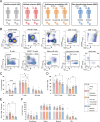Perturbances in Both Circulating B and CD4+ T Cells Discriminate Multiple Sclerosis from Other Central Nervous System Autoimmune Diseases
- PMID: 40899093
- PMCID: PMC12405970
- DOI: 10.1002/eji.70049
Perturbances in Both Circulating B and CD4+ T Cells Discriminate Multiple Sclerosis from Other Central Nervous System Autoimmune Diseases
Abstract
Using spectral flow cytometry, we analyzed circulating lymphocyte subsets in treatment-naive individuals with multiple sclerosis (MS) and other central nervous system autoimmune diseases (CNS AIDs). Elevated B-cell and CD4+ T-cell frequencies were a disease-specific feature of MS, while reduced T-bet+ and CXCR3+ B-cell levels were associated with progressive disease.
Keywords: MOGAD; anti‐AQP4 NMOSD; autoimmune encephalitis; disease progression; disease specificity.
© 2025 The Author(s). European Journal of Immunology published by Wiley‐VCH GmbH.
Conflict of interest statement
I.S. has received speaker fees from Biogen, Merck, and Sanofi. M.J.T. has filed a patent, on behalf of the Erasmus MC, for methods for typing neurological disorders and cancer, as well as devices for use therein, and has received research funding from EpilepsieNL (NEF 14‐19 & 19‐08), Dioraphte (2001 0403), ZonMw (Memorabel fellowship, VIMP scheme and Open Competition [ACT‐MD]), ItsME, Erasmus MC Foundation, and Erasmus Trustfonds. M.J.T. has served on the scientific advisory board of Horizon Therapeutics/AmGen, ArgenX, and Arialys; for consultation at Guidepoint Global LLC, and at UCB. M.J.T. is co‐PI of the EXTINGUISH trial. M.J.T. has received unrestricted research grants from Euroimmun AG and CSL Behring. M.J.T. has filed a copyright on behalf of ErasmusMC for the PROSE (Patient‐Reported Outcome Scale in Encephalitis). J.S. reports grants for scientific research from Biogen, Hansa Biopharma, Roche, and Siemens Healthineers, and has received speaker and/or consultancy fees from Biogen, Merck, Novartis, Roche, and Sanofi. M.M.v.L. has received research support from EMD Serono, Merck, Novartis, GSK, and Idorsia Pharmaceutical Ltd. The remaining authors declare no conflicts of interest.
Figures


References
-
- Sabatino J. J., Pröbstel A.‐K., and Zamvil S. S., “B Cells in Autoimmune and Neurodegenerative Central Nervous System Diseases,” Nature Reviews Neuroscience 20, no. 12 (2019 Dec): 728–745. - PubMed
MeSH terms
Substances
Grants and funding
LinkOut - more resources
Full Text Sources
Medical
Research Materials

